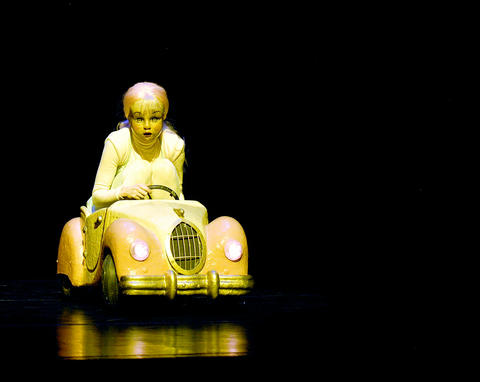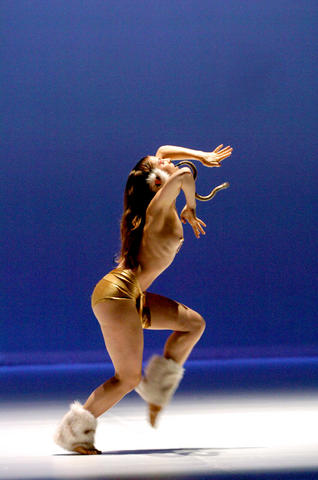The National Theater creative team has put together an impressive package for this year's Spring Dance series: a mix of international and local companies, big and small, well-known names and new ones, with a very Gallic flavor.
The team chose to make a bold statement by opening the series tonight with the latest production by the Montreal-based Compagnie Marie Chouinard, Orpheus and Eurydice. The piece had its world premiere at the Equilibrio festival in Rome on Feb. 6 and the company has arrived straight from an engagement at the Hong Kong Arts Festival last weekend.
The company stunned Taipei audiences at the National Theater two years ago with Chouinard's bODY_rEMIX/gOLDBERG_Variations, which explored the human body and its limitations with an intriguing mix of crutches, harnesses, bars and all sorts of appendages.

PHOTO: COURTESY OF NTCH
As they were with that production, the local press appears preoccupied by the amount of female nudity in Orpheus and Eurydice. Granted, both the men and the women of the company are topless throughout the performance, and the women are usually wearing more around their ankles and heads - in the form of fur cuffs and hats - than anywhere else, but Chouinard has repeatedly said that she sees the nude body as a vehicle for art rather than a source of titillation.
The 53-year old Quebecer has a long history of provocative work, and the two-act Orpheus and Eurydice looks set to be no different. Inspired by Beethoven's Ode to Joy (the original title of the dance was Ode to Joy L.I.V.E.) Chouinard uses the mythology of the classic Greek tale of love and passion to weave a story about what she calls the birth of language and the link between language and the body.
This is definitely not a production for children. In addition to nudity, there is a lot of simulated sex in the second half, which reportedly prompted some in the Hong Kong audiences to leave early.

PHOTO: COURTESY OF NTCH
Youngsters, however, will certainly enjoy the second show in the spring series. Next Thursday, one of the top ballet companies in the world, the Lyon Opera Ballet, opens a four-performance run of their most popular production, Maguy Marin's Cendrillon.
The celebrated French choreographer has spliced and rearranged Sergei Prokofiev's wonderful score with the sounds of babies to create a background for her retelling of the Cinderella story, set in a fabulous Toyland designed by Montserrat Casanova. The dancers all wear full head masks that turn them into chubby-cheeked, blank-faced dolls, the better to project an image of a lost childhood.
The masks, by Monique Luyton, along with Casanova's set and costumes, create a rich fantasy world that perfectly matches Marin's imaginative choreography. Several elements of the fairytale have been updated: Cinderella has a mini pink convertible instead of a pumpkin coach, her fairy godmother appears to be a robot with a neon wand, the ballroom scene is filled with children's games instead of gowned women, and the prince embarks on a world tour, accompanied, of course, by his dogs and cats, to find the foot that will fit his beloved's slipper.
The dancers' movements and actions are often childish and awkward, but Marin never loses sight of the love story at the heart of the Cinderella tale.
After the Lyon troupe heads home, the spring dance series is interrupted by a six-week break before coming back with a double-bill. Taiwan's famed Neo-Classic Dance Company (新古典舞團) will be in the main theater from May 16 to May 18 with 1957A.D., and the French/Taiwanese duet Double C will perform Reflex in the Experimental Theater.
The 32-year-old Neo-Classic Dance Company was founded by one of the doyen of modern dance in Taiwan, Liu Feng-shueh (劉鳳學), who began her career in 1950. Her work has combined Western techniques with Chinese classical dance and, in recent years, with Taiwan's Aboriginal cultures. 1957A.D. is a retrospective of her work and features six pieces: Sparks, The Last Trail, Ambushed From All Sides, 24 Hours and 1 Second, Nilpotent and Figurines1 - Han Figurines.
Liu considers 1957 to have been a pivotal year for her and her works, hence the name of the program.
Double C was founded in 2001 by former Cloud Gate Dance Theatre soloist Wu Chun-hsien (吳俊憲) and Frenchwoman Chrystel Guillebeaud, a former member of Pina Bausch's Tanztheater Wuppertal. They met in 1998 when Wu was invited to work on the 25th anniversary celebration of Bausch's company. Now married and based in Wuppertal, the couple has produced several works that draw on their different cultural heritages.
Wu choreographed Reflex in 2006 under a commission from PACT Zollverein in Essen, Germany. A dance for four women, set to a score by Christoph Iacano, Reflex explores the world of reflex movement and instinctual reactions.
The following weekend will see French choreographer Thierry Bae in the Experimental Theater with a semi-autobiographical production of Journal d'Inquietude (Diary of Worries).
Journal tells the story of a dancer-turned-choreographer who is working on a solo but can't find anyone to perform in it, or to stage it. So he lies and says he has a famous dancer interested in the project, which wins him a spot on the bill of a dance festival. Now he has to deliver, and Journal recounts his quest to find a dancer and create the solo. Bae takes on all the live roles - interspersed with film clips of his meetings with various dancers his character is trying to recruit.
In previous productions there have been a lot of in-jokes that only people familiar with the French dance world might get, but they don't detract from the work itself.
Capping off the program the first weekend in June will be the Taipei's own Dance Forum (舞蹈空間) in a joint production with French choreographer/rock 'n' roller/clothing designer Christian Rizzo. Since it is a work-in-progress, not many details were available as of press time - not even the name of the piece. But Dance Forum founder and artistic director Ping Heng (平珩) says she and her dancers are very enthused by the chance to work with Rizzo, who had residencies with the Taipei Artist Village (台北國際藝術村) last year and in 2006.
Ping founded the forum as a collective that would provide opportunities for different dancers and choreographers to present modern works, so this collaboration certainly fits the bill. Rizzo and Dance Forum are scheduled to take the work on tour in Asia and France later this year.

In the March 9 edition of the Taipei Times a piece by Ninon Godefroy ran with the headine “The quiet, gentle rhythm of Taiwan.” It started with the line “Taiwan is a small, humble place. There is no Eiffel Tower, no pyramids — no singular attraction that draws the world’s attention.” I laughed out loud at that. This was out of no disrespect for the author or the piece, which made some interesting analogies and good points about how both Din Tai Fung’s and Taiwan Semiconductor Manufacturing Co’s (TSMC, 台積電) meticulous attention to detail and quality are not quite up to

April 21 to April 27 Hsieh Er’s (謝娥) political fortunes were rising fast after she got out of jail and joined the Chinese Nationalist Party (KMT) in December 1945. Not only did she hold key positions in various committees, she was elected the only woman on the Taipei City Council and headed to Nanjing in 1946 as the sole Taiwanese female representative to the National Constituent Assembly. With the support of first lady Soong May-ling (宋美齡), she started the Taipei Women’s Association and Taiwan Provincial Women’s Association, where she

Chinese Nationalist Party (KMT) Chairman Eric Chu (朱立倫) hatched a bold plan to charge forward and seize the initiative when he held a protest in front of the Taipei City Prosecutors’ Office. Though risky, because illegal, its success would help tackle at least six problems facing both himself and the KMT. What he did not see coming was Taipei Mayor Chiang Wan-an (將萬安) tripping him up out of the gate. In spite of Chu being the most consequential and successful KMT chairman since the early 2010s — arguably saving the party from financial ruin and restoring its electoral viability —

It is one of the more remarkable facts of Taiwan history that it was never occupied or claimed by any of the numerous kingdoms of southern China — Han or otherwise — that lay just across the water from it. None of their brilliant ministers ever discovered that Taiwan was a “core interest” of the state whose annexation was “inevitable.” As Paul Kua notes in an excellent monograph laying out how the Portuguese gave Taiwan the name “Formosa,” the first Europeans to express an interest in occupying Taiwan were the Spanish. Tonio Andrade in his seminal work, How Taiwan Became Chinese,